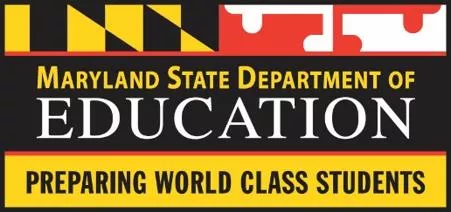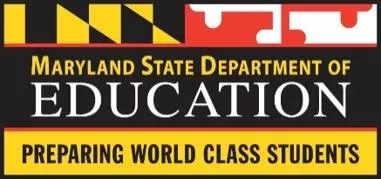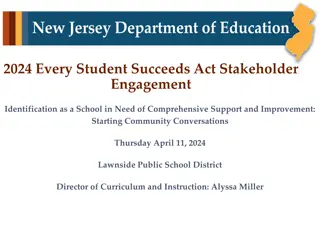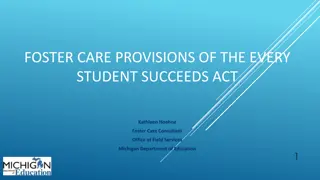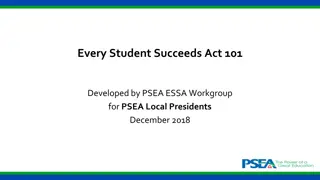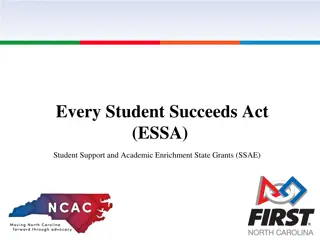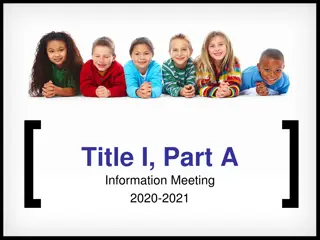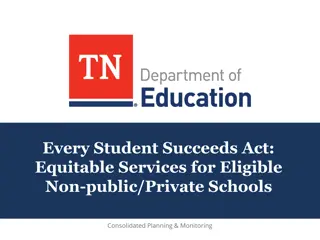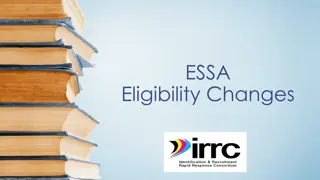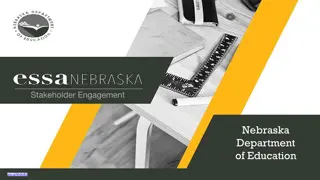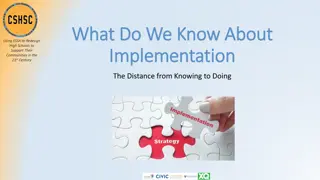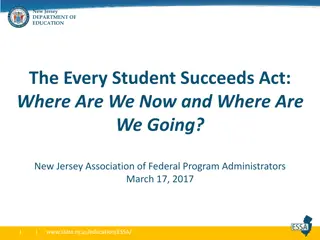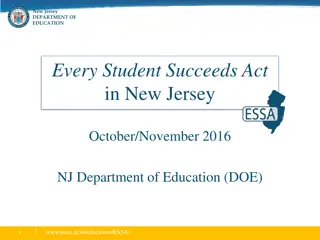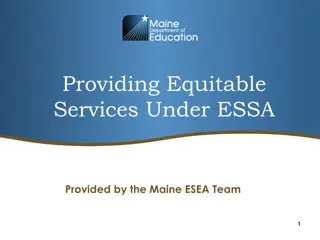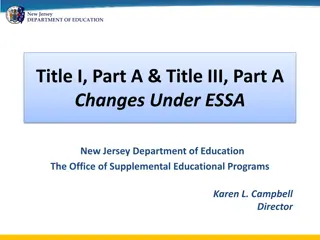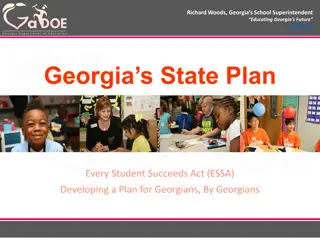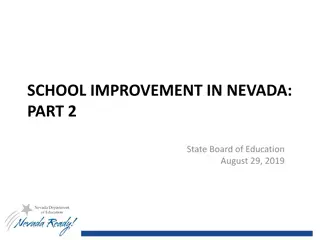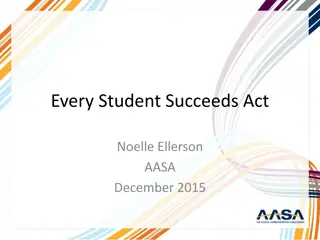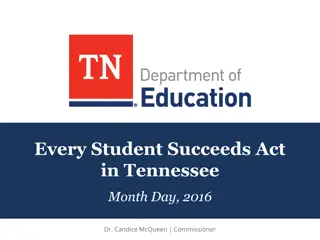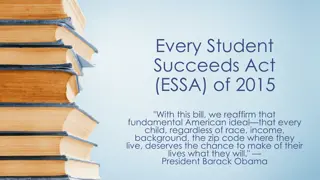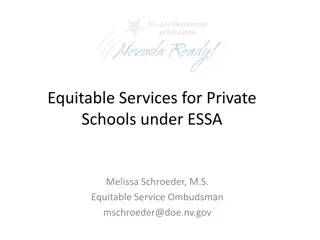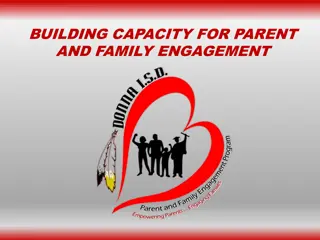Overview of Every Student Succeeds Act (ESSA) Implementation in Maryland
The Every Student Succeeds Act (ESSA) aims to provide a fair and quality education for all students, close achievement gaps, set academic goals, support educators and students, and improve schools. This summary covers the purpose, timeline, accountability frameworks, school frameworks, and key requirements of ESSA in Maryland.
Download Presentation

Please find below an Image/Link to download the presentation.
The content on the website is provided AS IS for your information and personal use only. It may not be sold, licensed, or shared on other websites without obtaining consent from the author. Download presentation by click this link. If you encounter any issues during the download, it is possible that the publisher has removed the file from their server.
E N D
Presentation Transcript
Every Student Succeeds Act (ESSA) Governor s P-20 Council June 6, 2017
Highlights of Major Sections of the Law and Maryland s Plan Purpose Timeline Accountability Support to Educators Support to Students 2
ESSA - Purpose Provide all students the opportunity receive a fair, equitable, and high quality education, and to close educational achievement gaps by: Establishing State standards, setting academic goals, and assessing progress toward those goals for all students and schools Measuring and reporting performance of all students, schools, and Local Educational Agencies (LEAs) Identifying and supporting schools in need of improvement Supporting professional development and growth for educators Supporting students to ensure a well-rounded education 3
Timeline for ESSA and Submission of Consolidated State Plan December 10, 2015 - Signed by President Obama February 2016 Committees formed to begin work, outreach, and monthly discussion with the State Board December 2016 - First Draft of Maryland s Plan available for feedback January 2017 Maryland s ESSA Listening Tour June 2017 Final Draft submitted to Governor, Legislative Policy Committee, and Website August 2017 Final Review by the State Board September 18, 2017 Submission to the U.S. Department of Education (120 day approval process) 2017-2018 School Year First year of implementation 4
Accountability Frameworks Selected measures Goals Example report card, dashboard Comprehensive Support and Improvement (CSI) Schools and Targeted Support and Improvement (TSI) Schools 2
Requirements and Constraints Protect Our Schools Act ESSA Indicators must be 10% Indicators must be of significant weight Academic must be of greater weight than Non-Academic Academic must be 65% and Non-Academic must be 35% Non-Academic indicators must include a survey and each measure must be at least 10% Non-Academic indicators must be valid and reliable 3 Categories for Indicators and Final Summative Cannot be A-F No/Minimal Summative calculation requirements Summative must use percentiles
Academic Achievement Recommended measure: Achievement composite Math composite: 10% of accountability score ELA composite: 10% of accountability score Performance index, Math 50% of math composite Performance index, ELA 50% of ELA composite AND AND Percent proficient+, Math 50% of math composite Percent proficient+, ELA 50% of ELA composite 9
Comparing recommended (composite) and alternative achievement measures Performance Index We value achievement at all levels. Percent proficient+ We have a standard. Composite We have a standard, and also value achievement above and below it. Message Both High achieving schools have Few 1 s and 2 s More 4 s than 3 s Yes Schools might focus on students at the boundaries. No Schools might focus on students at the 3/4 boundary. Partially Both, but one offsets the other. SGP would also offset focusing on boundaries because all growth is recognized, not just growth across a boundary. Is a 3 valued ? Unintended consequences 13
Academic Achievement 1. The composite will be used as the academic achievement measure. 2. The weight of the performance index and percent proficient+ will be 50-50. 3. In the performance index, a PARCC level 5 is worth a 5. 15
Academic Progress Recommended measure: Student growth percentile (Note: MD will study a Growth-to-Standard Model in combination with the SGP) SGP, Math: 12.5% of accountability score SGP, ELA: 12.5% of accountability score Median SGP, Math Median SGP, ELA 16
Academic Progress (Elementary School) Credit for completion of a well-rounded curriculum 5% - Percent of students scoring proficient on the Maryland Integrated Science Assessment (MISA) which will be field tested with MD fifth graders 2016- 2017 and will be operational in 2017-2018. 5% - K-3 Progress (DRAFT/Under study) Maryland will investigate this measure 28
Academic Progress (Middle School) Credit for completion of a well-rounded curriculum 3.5 % - The Maryland Integrated Science Assessment (MISA) will be field tested with MD eighth graders 2016-2017 and will be operational in 2017-2018. 3.5% - Social Studies Assessment will be field- tested in 2018-2019 and will be operational in 2019-2020. 3.0% - Percent of students passing certain subjects in 8th grade 28
Graduation Rate High Schools Four Year Cohort Rate (10%) Five Year Cohort Rate (5%) 17
English Language Proficiency Progress in achieving English Language Proficiency Percentage of students making progress towards attaining English Language Proficiency as measure by growth on the Access assessment for English Language Learner 18
Readiness for Post Secondary Success 10% - On-track in 9th grade percent of 9th grade students earning at least 4 credits in English/Language Arts, Math, Social Studies, Science or World Language 10% - Credit for Completion of a Well Rounded Curriculum 19
Credit for completion of a well- rounded curriculum (High School) subject to approval Percent of 12th grade students graduating or exiting with a certificate of completion, and receiving any of the following: Score of 3 or better on an Advanced Placement (AP) Exam or score of 4 or better on an International Baccalaureate (IB) Program Exam, Meet a standard set by the College Board on the SAT examination (score of 530 or higher (math) and 480 or higher (reading)), Meet a standard set by ACT, Inc. on the ACT examination (score of 21) Credit for Dual Enrollment, Completion of an industry certification or apprenticeship from a Career and Technology (CTE) Program, Meet a standard on the ASVAB examination (standard to be determined pending study), Enrollment in a postsecondary institution within 16 months after graduation. Entered the world of work** through gainful employment; post secondary education and training; supported employment; and/or other services that are integrated in the community. 20 29a
School Quality/Student Success: Access to a well-rounded curriculum (All Schools) Elementary School: Enrolled in Science, Social Studies, Fine Arts, Physical Education, and Health Middle School: Enrolled in Fine Arts, Physical Education, Health, STEM, Technology, Computer Science High School: Enrolled in Advanced Placement (AP), International Baccalaureate (IB), Career and Technology Education (CTE) Concentrator 21 30a
Goals ESSA: We must have ambitious long-term goals and measurements of interim progress for academic achievement, graduation rate, and EL proficiency. 36
Academic achievement long term and interim goals Option A: Annual Measurable Objective methodology Closing achievement gaps 100 Meeting interim targets will result in closing achievement gaps 90 Percent Proficient 80 70 60 50 40 30 American Indian/Alaskan Black/African American Hawaiian/Pacific Islander Two or More LEP Asian Hispanic/Latino White SWD FARMS 20 10 0 2017 2018 2019 2020 2021 2022 2023 2024 2025 2026 2027 2028 2029 2030 Closing achievement gaps: Every student group will start in a different place depending on the baseline, and student groups farthest behind have the most progress to make. Baseline 23 39
MSDE recommends the AMO method, cutting proficiency gaps in half by 2030 MSDE recommends long term and interim goals that are rigorous and attainable. A Proficiency Level of 4 and 5 is both a rigorous and attainable goal. Currently over half of the student groups at elementary and middle schools have a percent proficiency of less than 30%. Using a long term goal of 2030, the interim targets would be 2.7% or greater, which is rigorous and attainable. Although a state target of 90% would be rigorous, the interim targets would not be reasonable nor attainable. Stakeholders strongly recommended attainable and realistic goals. 1500 No. of Student Groups at Proficiency Ranges 121512691196 975 1000 699 613 472 500 249 121 25 0 10 20 30 40 50 60 70 80 90 100 24 40
Identification of Comprehensive Support and Improvement (CSI) Schools The lowest five percent of Title I schools based on the accountability system (identified in 2018-2019; approximately 22 schools) High schools with a 4-year cohort graduation rate of less than 67 percent (identified in 2018-2019; approximately 30 schools) School Improvement Grant (SIG) IV schools (includes five schools which began implementation in 2016-2017 and will continue through 2020-21) Low performing student group (TSI) schools with a student group performing in the bottom five percent of all students based on the accountability system for two years (to be identified in 2021-22) Other State Identified Schools: Maryland will also identify all schools in the bottom 5 percent based on the accountability system. (identified in 2018-2019; approximately 70-80 schools) 46
Identification of Targeted Support and Improvement (TSI) Schools Low-performing student group TSI Schools: Schools with one or more low-performing student groups performing below the summative performance of the all students student group in any of the lowest performing five percent of Title I schools (identified in 2018-2019) or a school does that not meet its 95 percent participation for any student group. Consistently underperforming TSI Schools: Schools with any student group not meeting its annual targets for two or more years based on the accountability system (identified in 2019-2020) 47
Identifying the Lowest 5% of Schools ESSA- States must: Create a meaningful differentiation system for all schools Create a State determined methodology based on the system of meaningful differentiation Protect Our Schools Act: Each LEA must develop an Improvement Plan which must include the school quality indicators described in the State law
Support to Teachers Teacher preparation reform, aligned with teacher requirement, induction, and retention Expand the skills of educators Expand Certification Options Provide support to all educators 28
Support to Students Provide all students with access to a well- rounded education; Improve school conditions for student learning; and Improve the use of technology in order to improve the academic achievement and digital literacy of all students. 29
Improve access and opportunity Providing support for students taking the Advanced Placement (AP) or International Baccalaureate (IB) exams; Advanced level coursework for all students; Access to instruction in all content areas beginning in Prekindergarten; Strategies to encourage and provide access to integrated STEM core concepts and practices for all students, specifically for female and students of color; More college preparatory support in all schools, specifically focusing on low-income schools (i.e. Advancement Via Individual Determination (AVID) Program); Diverse fine arts options for all students to foster creative problem solving, individual growth, meaningful expression, and innovation; Quality physical education for all students to gain the academic and health benefits of movement and fitness; Comprehensive health education that provides students the skills to adopt and sustain behaviors that promote a healthy lifestyle and reduce health risks 30
Improve the effective use of technology School systems have limited capacity and resources to provide and/or expand access to high quality digital learning experiences for all students including students in remote and rural areas and under- represented student groups. School systems often do not have trained staff members who possess the necessary qualifications to review digital resources, including online courses, for web accessibility compliance. Educators and students must be provided flexible platforms that allow for online professional development and student course delivery (Learning Management System). There is a lack of equity in regard to support provided by LEAs for their school library media programs. 31
Other Improve the communication between home and schools. Provide training of general education teachers across all content areas on language acquisition and strategies for serving English Learners (ELs) as this increases access for ELs to a well- rounded education; and, Increase the training of teachers across all content areas on identifying and serving gifted and talented students to increase access and success for all students. 32
Questions? 33

 undefined
undefined

